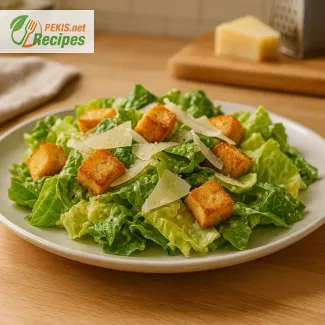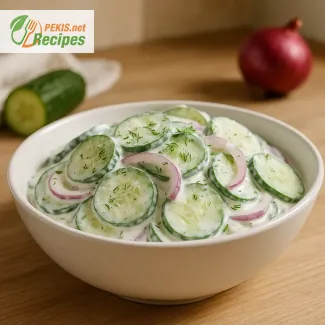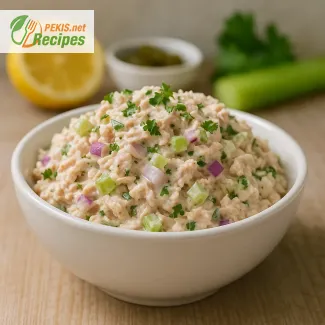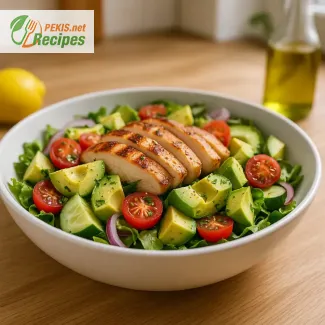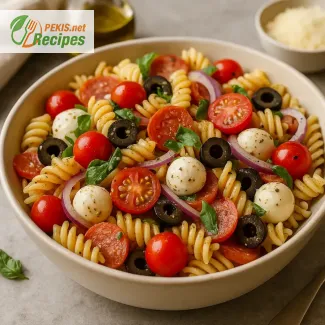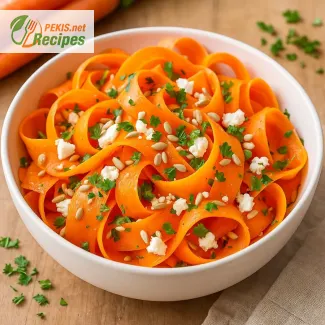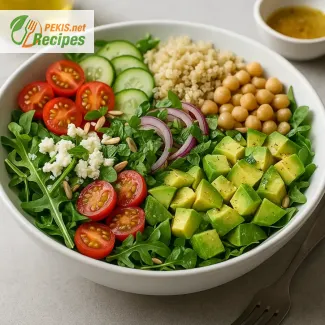
Light and Tasty: A Perfect Midday Summer Meal
Why this summer lunch idea hits all the right notes
When the sun is high and appetites lean toward something fresh, light, and satisfying, a well-composed summer lunch recipe becomes more than just a meal—it’s a moment of seasonal joy. This recipe captures that essence with a balanced blend of refreshing textures, vibrant colors, and layered flavors, offering everything one craves during warmer days. Crafted with simplicity and elegance, it’s the kind of dish that can anchor a casual outdoor lunch, impress guests at a garden party, or simply provide a moment of serenity on a busy weekday.
More than just a quick bite, this is a flavorful combo that speaks to the ingredients of the season—juicy vegetables, cooling herbs, zesty citrus, and proteins prepared to let their natural flavor shine. Served cold or slightly warm, it fits effortlessly into any summer setting, from a picnic in the park to a breezy home terrace gathering.
The essence of a truly refreshing summer plate
The success of a great lunch during summer lies in the interplay of coolness and crispness, balanced by flavor-forward elements that don’t weigh down the body. This recipe highlights the season’s best produce, harmonizing textures like creamy, crunchy, and tender, while keeping seasoning bright and intentional. The ingredients are thoughtfully selected not just for taste, but also for their ability to hydrate and satisfy, making this lunch both revitalizing and fulfilling.
You won’t find heavy sauces or complex reductions here. Instead, expect a focus on natural freshness—from thinly sliced cucumbers, ripe tomatoes, and aromatic herbs, to lightly grilled protein or plant-based additions like chickpeas or quinoa. The result is a vibrant meal that looks as beautiful as it tastes.
How temperature, texture, and timing play a role
One of the core principles behind this refreshing summer lunch is temperature contrast. While some elements may be prepared in advance and served chilled, others are lightly sautéed or grilled and added just before serving. This layered approach offers a dynamic mouthfeel, keeping each bite engaging. Texture plays an equal role—crisp vegetables, creamy dressings, and chewy grains or toasted nuts add structure and interest.
Timing is also key. Many components can be made the night before or in the early morning when the kitchen is cooler, allowing the flavors to develop and mingle. Assembly takes minutes, but the result is visually appealing, nutritionally balanced, and perfectly suited for high noon indulgence.
A versatile option for varied summer occasions
Whether you’re crafting a quick solo lunch, packing a workday meal prep, or setting out a shareable family platter, this easy summer lunch offers flexibility. It works beautifully as a standalone bowl, layered salad, or even as an open sandwich. And thanks to its refreshing character, it pairs seamlessly with chilled beverages like infused water, lemonade, or iced tea.
This recipe is also highly adaptable to dietary needs—vegetarian or gluten-free versions are easily created by swapping base ingredients while preserving flavor. It’s a celebration of modern seasonal cooking that doesn’t require a culinary degree, just good taste and good timing.
Spotlight on freshness and seasonal ingredients
Key to this summer meal is using ingredients at their peak ripeness. Look for firm but juicy tomatoes, herbs picked just before use, and fresh citrus for zest and juice. Leafy greens like arugula or baby spinach add a peppery undertone, while protein elements such as grilled chicken, tofu, or legumes provide substance.
To tie everything together, the dressing is light yet flavorful—think olive oil, lemon juice, garlic, and a touch of mustard or honey, whisked to perfection. Drizzled just before serving, it enhances without overpowering, allowing the natural ingredients to take center stage.
Ideal for prepping ahead or spontaneous lunches
This summer lunch recipe suits both planners and last-minute cooks. Many ingredients can be pre-cut and stored in the fridge in airtight containers. Proteins can be marinated and grilled in advance. When hunger strikes, all it takes is a few minutes of assembly. It's the kind of meal that can be packed to-go or plated beautifully for guests.
For those seeking balance, flavor, and ease, this lunch delivers every time. It respects the rhythm of summer: laid-back yet vibrant, casual yet thoughtful, light but full of life. The kind of meal that doesn’t just fill you up, but leaves you energized and ready to enjoy the rest of the day.
- Cook the quinoa if not pre-cooked: Rinse 100 g dry quinoa under cold water, then cook in 200 ml (6.8 fl oz) water with a pinch of salt for 10–12 minutes until fluffy. Let it cool completely.
- Prepare the dressing: In a small bowl, whisk together olive oil, lemon juice, minced garlic, Dijon mustard, honey, salt, and black pepper. Set aside.
- Chop the vegetables: Halve the cherry tomatoes, thinly slice the cucumber and red onion, and dice the avocado. Gently chop the mint leaves.
- Assemble the base: In a large salad bowl or platter, layer the mixed greens, cooled quinoa, chickpeas, cherry tomatoes, cucumber, and avocado.
- Top with extras: Add red onion, crumbled feta cheese, chopped mint, and sunflower seeds on top of the vegetables.
- Dress the salad: Drizzle the dressing evenly over the assembled salad just before serving. Gently toss to combine or serve as-is for a composed presentation.
- Serve immediately, or chill in the refrigerator for 15 minutes if preferred extra cold.
Creative Upgrades for a Refreshing Summer Lunch
Proven ways to elevate taste, texture, and nutritional balance
The beauty of a well-balanced summer lunch lies in its versatility. While the base recipe already showcases seasonal freshness, there are many ways to enhance flavors, introduce new textures, and even adjust nutritional content. By experimenting with ingredient swaps or fine-tuning techniques, you can make this dish uniquely yours without compromising its core identity. Whether your goal is a gourmet twist, a lighter variation, or just a more vibrant presentation, the options for refinement are rich and rewarding.
Add-ins that boost flavor and complexity
Introducing additional fresh herbs like basil, tarragon, or chives can layer delicate aromatic notes over the base of mint. These elevate the herbaceous quality and pair beautifully with avocado and feta. Swapping Dijon mustard for wholegrain mustard adds subtle bitterness and texture to the dressing, while a few drops of white balsamic vinegar can round off acidity without overpowering the citrus profile.
For those who prefer a bolder kick, a pinch of Aleppo pepper or smoked paprika in the vinaigrette delivers a hint of heat and depth. Crumbled goat cheese instead of feta introduces tangier notes, and grilled halloumi slices offer both texture and flavor contrast, making the salad feel more substantial.
Ingredient swaps for health-conscious eaters
To lower sodium while keeping flavor, reduce the feta and increase fresh herbs and lemon zest. Replacing honey with a small amount of blended fresh mango or pear purée provides natural sweetness and fiber. Instead of chickpeas, try edamame or steamed lentils for more variety in plant-based protein and a nuttier undertone.
Opting for hemp seeds or pumpkin seeds in place of sunflower seeds increases omega-3 intake and adds crunch. For more fiber and mineral content, substitute quinoa with freekeh or bulgur wheat, keeping in mind these options contain gluten and are less ideal for those with sensitivities.
Why homemade makes a real difference
Making this meal at home offers full control over ingredient quality, seasoning levels, and freshness. Store-bought or pre-packaged salads often contain preservatives, hidden sugars, or oils of lower nutritional value. By preparing everything from scratch, you're guaranteed maximum flavor with minimal processing, especially in elements like the dressing, which can be made without additives.
You also gain the flexibility to adjust portions based on your appetite or activity level—something rarely achievable with pre-made meals. The freedom to use organic produce, select grass-fed dairy, or control oil types allows for greater alignment with your personal health goals.
Common mistakes to avoid when preparing this meal
One of the most frequent errors is overdressing the salad. Too much vinaigrette can make the greens soggy and overpower more delicate flavors. It’s best to dress just before serving and use a light hand, then allow diners to add more if needed.
Another pitfall is improperly cooked quinoa—either undercooked and crunchy or overcooked and mushy. The key is rinsing thoroughly and using the correct water ratio (2:1) for fluffy, separate grains. Similarly, slicing vegetables too early and storing them uncovered can lead to oxidation, especially with avocado and red onion.
Lastly, skipping a cool-down period for warm ingredients like grains or chickpeas can wilt greens and alter the intended texture. Let these components come to room temperature or chill them slightly before assembly.
Enhancing visual appeal and presentation
A dish that’s visually vibrant will always feel more satisfying. Using heirloom cherry tomatoes in yellow, orange, and red enhances the plate’s color palette. Slicing avocado in fans instead of cubes creates a more refined look. Arranging ingredients in sections or concentric rings rather than tossing everything together brings restaurant-level elegance to the home table.
A small handful of edible flowers, such as nasturtium or viola petals, can be added as a final garnish for color and a slight peppery note. Serving the salad on a chilled ceramic plate or in individual glass bowls also improves the overall dining experience, especially on a hot summer day.
Adjusting for seasonal shifts and personal preferences
Though built for summer, the concept can easily carry into other seasons. Replace tomatoes with roasted squash or beets in autumn, or switch greens for kale or shredded cabbage in winter for sturdier bite and fiber. You can also replace chickpeas with cannellini beans or roasted sweet potato cubes for more seasonal alignment.
For protein boosts, consider adding slices of hard-boiled eggs, grilled tofu, or cold poached salmon, depending on dietary preferences. These upgrades maintain the meal’s balance while introducing new nutritional dimensions.
By tuning into your preferences and the ingredients available, this salad evolves from a simple lunch to a thoughtful, intentional meal with personality—and one that you’ll keep returning to, all summer long.
Allergens present in the recipe:
- Milk (feta cheese)
- Mustard (Dijon mustard)
- Gluten-free by default if quinoa is certified gluten-free.
Tips to eliminate allergens and gluten:
- Replace feta cheese with a plant-based alternative for a dairy-free version.
- Replace Dijon mustard with a homemade vinaigrette using lemon zest and olive oil.
- Ensure quinoa is labeled gluten-free to avoid cross-contamination.
Vitamins and minerals per serving (approximate):
- Vitamin C – 42 mg: Supports immune system and skin health.
- Vitamin A – 410 µg: Essential for vision and cellular growth.
- Vitamin K – 72 µg: Important for blood clotting and bone health.
- Folate (B9) – 150 µg: Aids cell division and red blood cell formation.
- Potassium – 720 mg: Helps regulate fluid balance and nerve signals.
- Magnesium – 60 mg: Supports muscle function and energy production.
- Iron – 3.2 mg: Helps transport oxygen in the blood.
- Calcium – 120 mg: Strengthens bones and supports nerve function.
Antioxidants per serving (approximate):
- Lycopene – 3.5 mg (from cherry tomatoes): Protects cells from oxidative stress.
- Lutein & Zeaxanthin – 1.2 mg (from greens and avocado): Supports eye health.
- Vitamin E – 3.1 mg (from sunflower seeds and avocado): Helps prevent cell damage.
- Flavonoids – 15 mg (from mint, onion, and greens): Anti-inflammatory and immune-supporting effects.
